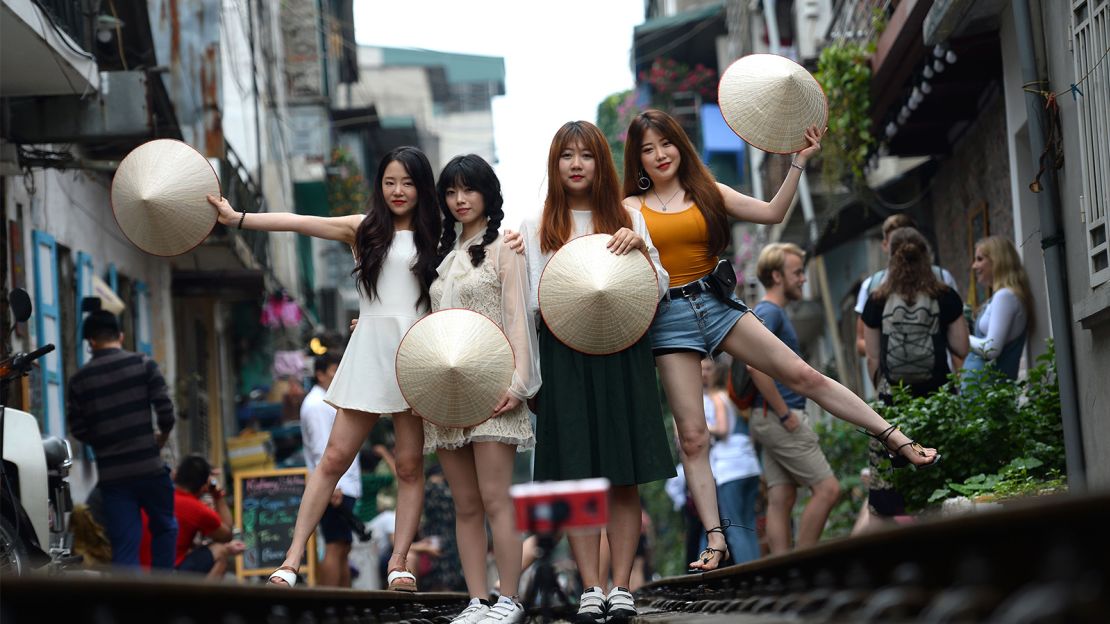Gone are the days when polite travelers would avoid walking in front of people so as not to get in their vacation snap – now, it’s all about not walking behind people to ruin their selfies.
Few places have selfie culture more on display than Hanoi, Vietnam, where the mix of old and new provides a fascinating photo backdrop for visitors. Hanoi’s “selfie street” is in the Old Quarter, along a set of train tracks originally built by French colonists.
And while selfie-takers can sometimes annoy locals as they block off sidewalks to get the perfect photo, there’s a bigger issue at play here in Hanoi – the train tracks are very much still operational, meaning that locals and visitors alike can risk their lives by not being careful when they stand on or walk across the tracks.
Many locals, who know the train schedules by heart and plan their day around them, have taken to giving visiting photographers a heads-up.

“It was fairly quiet when we went, as it was early in the day,” Instagrammer Christabel tells CNN Travel about her visit to “train street,” where she posted several photos on October 29. “The locals were super-friendly and they did mention the train times when we walked past.”
Christabel is just one of thousands who have shared pictures from “train street.”
Some people have gotten so obsessive about having the perfect social media-centric destination that they have hired professional photographers to follow them or visited an out-of-the-way location just in pursuit of an Instagram photo, giving birth to the phrase “do it for the ‘gram.”
A quick social media search shows photos of visitors sitting, running, jumping, dancing, kissing, pretending to fall and even planking along the tracks. Only a handful show an actual train going by.
Dave Fox, a Vietnam-based writer and writing coach, has watched locals-only places like “train street” become overcrowded in the era of social media. He first visited the street in 2010 and is sad to see it being “trampled” by tourists.
He has most recently been hearing stories of tourists who make a game of standing on the train tracks as long as possible, then jumping off just as the train comes – all while running a camera or GoPro.
“Overtourism is a new buzzword for something that has been going on a long time,” Fox tells CNN Travel.
Selfies are one thing, but he’s also concerned about what he calls “smash and grab” photography – snapping a photo of a local, then dashing off to the next attraction.
“Travelers need to be mindful of optics,” he says. “It’s fine to take people’s photos if you ask first and most people in Vietnam are nice. You need to treat people like human beings, not objects in a museum.”
Fox operates by a guiding principle: how would you feel if it happened to you? He asks travelers to put themselves in the mindset of the locals, and think about how they’d react if a stranger ran up and took their photo without permission.
While it seems that the local Vietnamese residents who live alongside “train street” are understanding of the people who come from around the world just to get their picture taken, not every destination has the same attitude.
Travel hotspots around the world, from Venice to New Orleans, are struggling to deal with overtourism. While selfie mania isn’t the only contributing factor, it definitely plays a role as places try to balance the number of people visiting an attraction with the amount of free publicity some gorgeous ‘grams can give them.
The Instagram “save” button was added in 2018 as a way to help users keep track of places they wanted to check out for their own travels and photo ops.
“Suddenly, some waterfall that’s kind of hidden away and not many people went to – all of a sudden it becomes really popular, because there’s been some celebrity post something on it or it’s in a popular TV show […] You can see that with some of the sites that have been featured in ‘Game of Thrones’ have become popularized,” says María Reynisdóttir, of Iceland’s Department of Tourism.
She adds: “And then all of sudden, lots of people start visiting but the site isn’t ready for the footfall. So then you need to be quick to react, but that isn’t always possible.”











